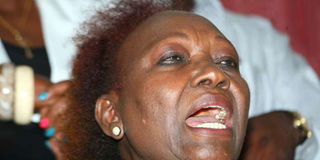Women paid less than men, report shows

Nominated Senator Beth Mugo addressing journalists at Parliament on September 24, 2015. In Kenya, women occupy only 21 per cent of all parliamentary seats. The country has tried to address this through Article 81(b) of the Constitution. PHOTO | EVANS HABIL | NATION MEDIA GROUP
What you need to know:
- It is expected that if the trend holds, it will take another 118 years for men and women to earn equal pay for equal work.
- In Kenya, women occupy only 21 per cent of all parliamentary seats. The country has tried to address this through Article 81(b) of the Constitution.
- The study shows women make up the majority of skilled workers in only 68 countries.
A Kenyan woman is paid Sh62 for every Sh100 paid to a man for doing a similar job, according to a report released on Thursday by the World Economic Forum.
The Global Gender Gap Report shows that this is a reality for women all over the world.
According to the report, women generally make less money than men for the same jobs.
What women are earning currently is what men were paid in 2006.
It is expected that if the trend holds, it will take another 118 years for men and women to earn equal pay for equal work.
The wage gap is calculated by dividing women’s average yearly income with that of men.
The report measures the gender gap in 145 countries worldwide based on education, health, political participation and economic opportunities.
Kenya was ranked position 48 this year, falling 11 positions from last year’s listing.
Across the world, political participation remains the worst-performing indicator, with the report showing an existing gap of 67 per cent.
“Only two countries have reached parity in parliament and only four have reached parity on ministerial roles,” said the report.
THE GENDER RULE
In Kenya, women occupy only 21 per cent of all parliamentary seats. The country has tried to address this through Article 81(b) of the Constitution.
It says: “Not more than two thirds of the members of elective or appointive bodies shall be of the same gender.”
If implemented, women will occupy at least 33 per cent of parliamentary seats — a milestone that has been achieved and surpassed by other countries in the East African region.
However, delays in tabling and debating the appropriate Bill in the National Assembly has stalled the implementation of the two-thirds gender rule, whose deadline elapsed on August 27 without substantive progress.
Although the report found that no country in the world has achieved gender parity on all the four indicators, 40 countries have closed the gap in the health sector.
It has the best-performing equality indicator, achieving 96 per cent gender parity.
This means that in most of the world, women receive the same access and quality of healthcare as men.
According to the report, the second best-performing sector is education, which is rated at 95 per cent.
This is true of tertiary education, where women are the majority in almost 100 countries in the world.
The report, however, found that better education opportunities did not translate into more participation of women in the workplace.
The study shows women make up the majority of skilled workers in only 68 countries.





